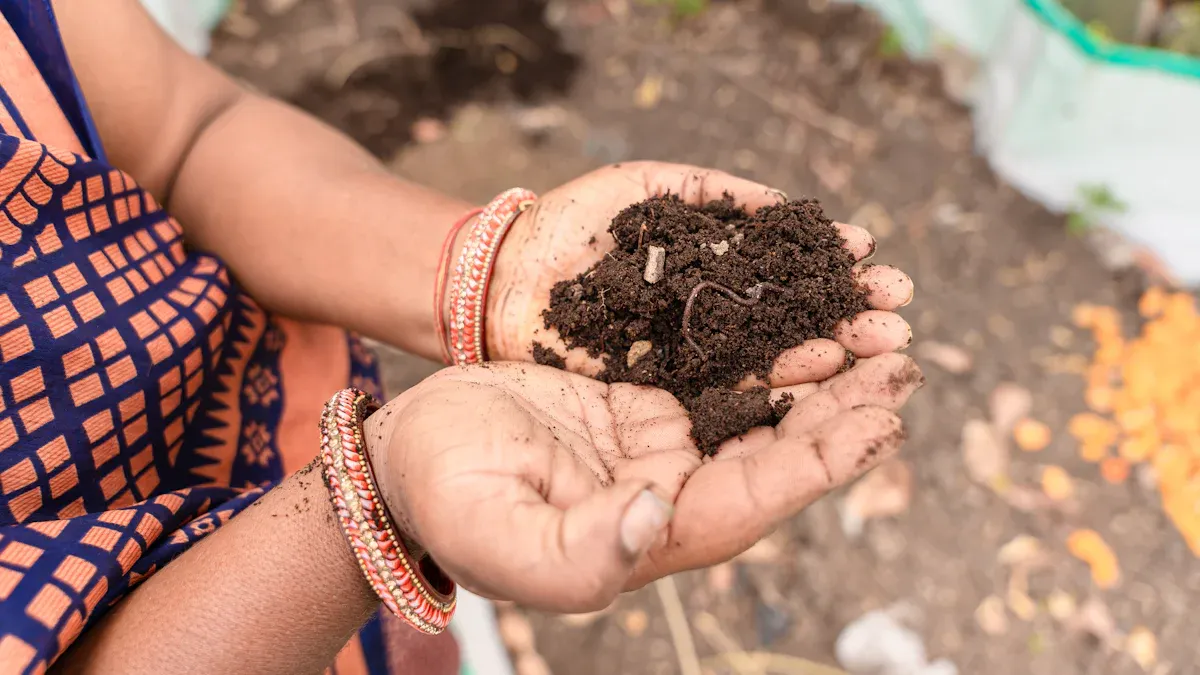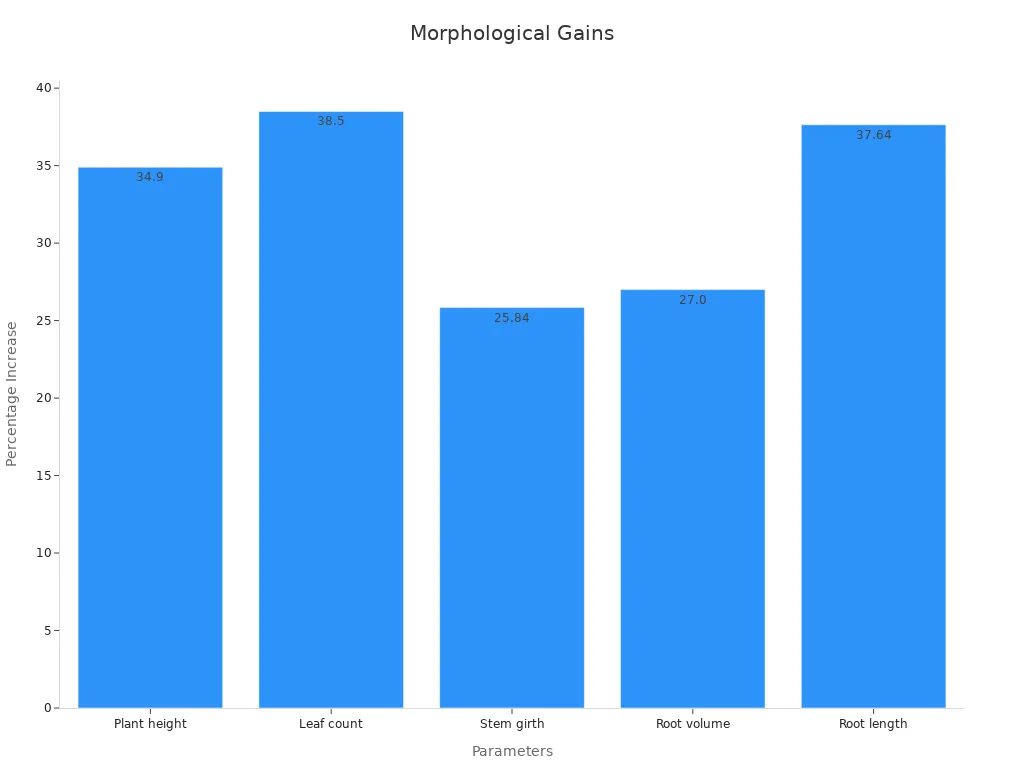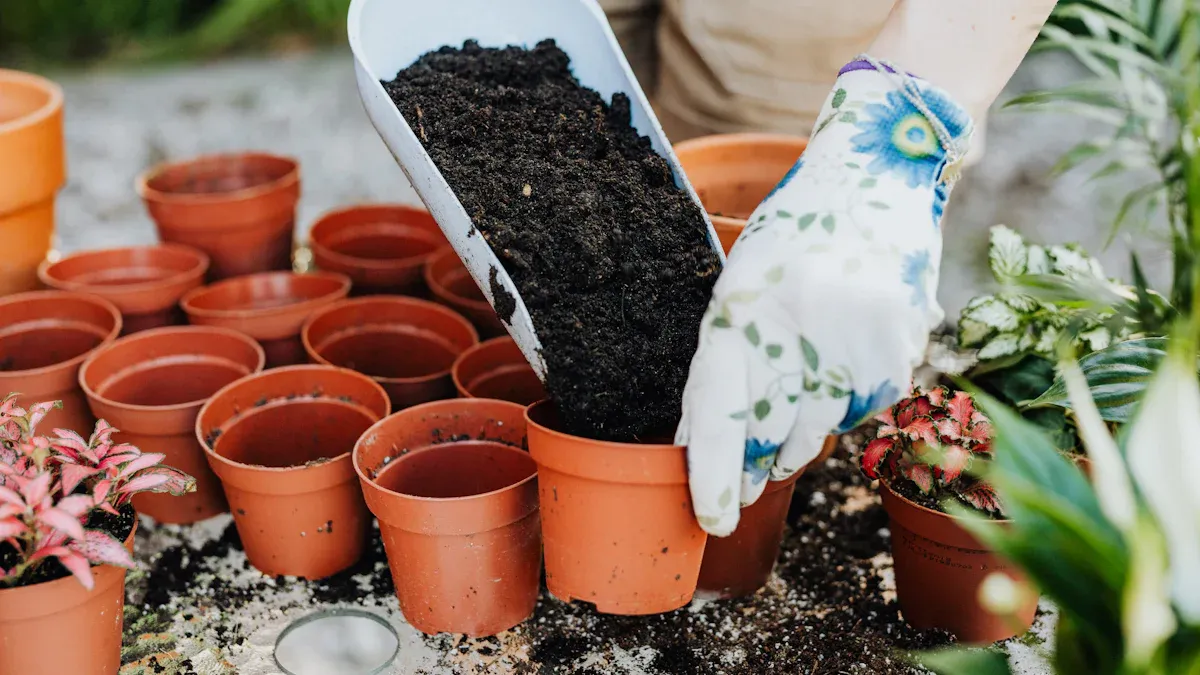Understanding Potassium Humate Fertilizer for Better Plant Growth

Potassium humate fertilizer is derived from natural sources and acts as a powerful soil enhancer. This organic potassium humate fertilizer strengthens plants by improving soil quality and boosting root nutrient absorption. Both farmers and gardeners have observed significant improvements, including a 17.2% increase in the soil’s nutrient retention and a 35% boost in green fodder yield when using potassium humate fertilizer. The data below highlights the positive impact of potassium humate fertilizer on plant growth.
Parameter | Percentage Increase |
|---|---|
Plant height | 34.9% |
Leaf count | 38.5% |
Root length | 37.64% |

Key Takeaways
Potassium humate fertilizer makes soil better by adding organic matter. It helps soil keep water and nutrients. It helps plants grow taller and make more leaves and roots. It helps plants handle stress like drought and heat. The fertilizer gives potassium to plants slowly over time. This means plants get nutrients for longer and less is wasted. Potassium humate helps good microbes in the soil. These microbes keep soil healthy and protect plants from disease. Using potassium humate with other fertilizers helps plants use nutrients better. It can also lower the need for chemical fertilizers. You can use potassium humate in different ways. You can add it to soil, spray it on leaves, or soak seeds in it. It is safe for most plants, pets, and the environment if you follow the directions. Potassium humate is not the same as regular potassium fertilizers. It makes soil healthier and gives potassium slowly.
What Is Potassium Humate Fertilizer?
Definition
Potassium humate fertilizer is made from natural materials with lots of carbon. People get it from leonardite or lignite, which are types of coal that have changed over time. This fertilizer has humic acid, fulvic acid, and potassium. These parts help soil and plants in many ways. Organic potassium humate makes soil better and gives plants more nutrients. It helps roots take in nutrients and keeps them strong and healthy.
Studies and tests show that potassium humate fertilizer, with its humic acid and potassium, helps plants make more food, take in more nutrients, and grow more crops. Crops like maize, tomatoes, and rice get greener leaves and can handle stress better. The carbon in organic potassium humate helps soil keep water and nutrients.
Main Components
Potassium humate fertilizer has three main parts:
Humic acid: This comes from old plant material. It adds carbon to soil and makes soil structure better.
Fulvic acid: This small part helps plants get nutrients. It also helps minerals move in the soil.
Potassium: This important nutrient helps plants grow, stay strong, and make better crops.
These three parts make potassium humate fertilizer special. The carbon in humic and fulvic acids helps soil hold water and nutrients. Potassium makes plant cells stronger and helps them live through hard times.
Tests in fields and greenhouses show that potassium organomineral fertilizers, like potassium humate, help good microbes grow in the soil. These fertilizers give out potassium slowly, lower salt in the soil, and add organic matter. This leads to better soil pH, more nutrients, and more kinds of helpful bacteria and fungi.
How It Differs
Potassium humate is different from regular mineral fertilizers and other soil helpers. Most mineral fertilizers give nutrients but do not make soil structure or organic matter better. Potassium humate fertilizer adds carbon and organic matter to soil. This makes soil healthier as time goes on.
Regular potassium fertilizers, like potassium chloride, give nutrients fast but can make soil salty.
Organic potassium humate gives potassium slowly and does not cause salt problems.
Other soil helpers may not have the same mix of humic acid, fulvic acid, and potassium.
Research shows that potassium humate fertilizer, when used with NPK fertilizers, helps soil keep more nitrogen and helps plants use nutrients better than NPK alone. This mix helps plants make more food, grow more seeds, and use nitrogen better. The carbon in organic potassium humate also helps keep nitrogen in the soil and helps good microbes grow.
Tip: Gardeners and farmers can use potassium humate to make soil better and give plants more nutrients. This makes it a great choice for farming that is good for the earth.
How It Works
Soil Structure
Potassium humate changes how soil is built. When you add it, it connects soil pieces together. This connection lets air and water move better. The soil can hold more water and drains faster. In tests, potassium humate helped soil keep more important nutrients. It also made the soil less salty and more fertile. These changes help plants grow taller and make more leaves and roots. The carbon in potassium humate feeds tiny living things in the soil. These tiny things help make the soil strong. Over time, the soil becomes less acidic and better for all crops.
Note: Potassium humate works in both sandy and clay soils. It helps sandy soil keep water and food for plants. It also makes clay soil softer so roots can grow deeper.
Nutrient Availability
Plants need nutrients all the time to grow well. Potassium humate holds onto plant food and lets it out slowly. This slow release gives plants a steady supply of nutrients. It stops nutrients from washing away with rain or water. Humic and fulvic acids in potassium humate grab minerals. They make it easier for roots to take in these minerals. In one study, potassium humate helped soybeans get iron in hard soil. This shows it can help plants get more nutrients. The active parts in potassium humate help plants take in more potassium, nitrogen, and phosphorus. This gives plants energy to grow strong stems, healthy leaves, and big roots.
Tip: Using potassium humate with other fertilizers helps plants use food better. It can also lower the need for extra chemical fertilizers.
Microbial Activity
Healthy soil needs lots of tiny living things. Potassium humate gives these microbes the carbon they need. When microbes break down old plant parts, they release food for plants. Studies show that soil with potassium humate has more microbes than soil without it. In one test, the number of microbes grew by over 150% after adding potassium humate. The balance between fungi and bacteria got better too. This helps trees and other plants fight disease. These microbes keep the soil healthy and in good shape. They also help break down bad salts and make more food for plants.
Callout: Microbes are nature’s helpers. They turn old plant parts into food for plants and keep soil alive and healthy.
Benefits of Potassium Humate
Plant Growth
Potassium humate helps many crops grow better. When farmers use this fertilizer, plants get taller and have more leaves. Their stems also become stronger. Scientists saw that potassium humate makes plants like maize, tomatoes, and rice grow higher and thicker. In foxtail millet, it made the panicles longer and added more spikelets. This gave farmers more grain. Potassium humate helps plants make more chlorophyll. Chlorophyll gives leaves a dark green color. It also helps plants catch more sunlight. With more chlorophyll, plants turn sunlight into energy faster. This helps them grow bigger and healthier.
Tip: Fast-growing plants can beat weeds and make more food for people and animals.
Root Development
Roots help plants get water and nutrients from the soil. Potassium humate helps roots grow by changing plant hormones. These hormones tell roots to grow longer and branch out. In tests, plants with potassium humate had longer roots and more root hairs. This lets them reach deeper for water and minerals. Peanuts and beans grew thicker roots and more side roots with this fertilizer. These changes help plants live through dry times and poor soil. Strong roots also help plants stand up in wind and rain.
Plants with better roots can:
Take in more iron and other nutrients
Grow faster when it is dry
Stay healthy in hard soil
Stress Resistance
Plants face problems like drought, heat, and disease. Potassium humate helps plants deal with these problems. It helps plants use water better and keep their leaves green when it is dry. In maize, potassium humate helped plants make more food from sunlight and fight drought. The fertilizer also makes plant cells stronger. This helps plants fight off pests and bad weather. Studies show that crops with potassium humate have bigger harvests and better quality, even when the weather is not good.
Callout: Farmers and gardeners who use potassium humate see their plants stay healthy and strong, even when the weather is bad.
Fertilizer Efficiency
Potassium humate helps farmers and gardeners get more from fertilizer. This organic amendment works with chemical and organic fertilizers. It makes nutrients easier for plants to use. It also keeps nutrients in the soil longer.
Plants lose nutrients when rain washes them away. Potassium humate holds onto these nutrients like a sponge. It soaks up plant food and lets it out slowly. This slow release means plants can eat when they need to. Plants do not have to eat all at once after fertilizing. Farmers see less waste and save money on fertilizer.
Tip: If you mix potassium humate with regular fertilizer, you may need less fertilizer. Many growers use up to 20% less fertilizer and still get good crops.
Potassium humate helps fertilizers work better in tough soils. In sandy soils, nutrients wash away fast. Potassium humate grabs these nutrients and keeps them near roots. In clay soils, it breaks up hard clumps. This lets roots reach more food. Plants get a steady supply of nutrients, even in poor soil.
Here are some ways potassium humate helps fertilizer work better:
Reduces nutrient loss: It stops nitrogen, phosphorus, and potassium from washing away.
Improves nutrient uptake: Roots can grab more food from the soil.
Balances soil pH: It helps keep soil from getting too acidic or too salty.
Supports soil microbes: Healthy microbes help break down fertilizer into forms plants can use.
Benefit | Result for Growers |
|---|---|
Less fertilizer needed | Lower costs |
More nutrients for plants | Bigger, healthier crops |
Fewer chemicals in runoff | Cleaner water, safer soil |
Farmers who use potassium humate see stronger plants and better harvests. They notice greener leaves, thicker stems, and more fruit or grain. Gardeners find that flowers bloom longer and vegetables taste better.
Note: Potassium humate works with most fertilizers. Always check the label for mixing instructions to get the best results.
Potassium humate helps the environment too. By holding onto nutrients, it keeps them out of rivers and lakes. This means less pollution and healthier ecosystems. Growers who use potassium humate help both their crops and the planet.
Potassium Humate Fertilizer Application

Soil Amendment
Many gardeners and farmers use potassium humate to make soil better. They spread dry granules on the ground or mix it into the top soil before planting. This helps the soil keep more water and nutrients. It also helps good microbes grow in the soil. In clay soil, potassium humate makes the ground softer for roots. In sandy soil, it keeps nutrients from washing away. Some people mix potassium humate with nitrogen fertilizer or organic matter. This makes the soil stronger and helps plants get more food. Potassium humate acts like a helper, making nutrients easier for plants to use. It does not give nutrients itself but helps plants use what is already there.
Tip: Always read and follow the instructions on the package. Different brands may need different amounts. Using the right amount gives the best results.
Foliar Spray
Another way to use potassium humate is by spraying it on leaves. Growers mix it with water and spray it right on the plant. This helps plants take in nutrients fast, especially when they are growing quickly. Foliar sprays work well in spring when the weather changes a lot. The amino acids in potassium humate help plants get better after cold weather. Spraying in the morning or late afternoon works best. Leaves can soak up the spray without getting burned. Mixing foliar sprays with other fertilizers can help plants grow even more.
Foliar spraying works best:
When plants are growing fast
After moving plants to new spots
When plants look stressed
Seed Soak
Soaking seeds or bulbs in potassium humate before planting helps them sprout evenly and grow strong. People soak seeds for several hours, usually between 12 and 24 hours. This depends on the type of plant. Soaking helps seeds handle stress and grow healthy roots. For young plants with bare roots, soaking before planting helps them settle in faster. It also helps them grow better in the soil. Using seed soaking along with spraying and soil mixing can help plants fight drought and grow strong.
Note: Potassium humate is safe and not harmful. Most people do not need special gear to use it.
Dosage and Timing
It is important to use the right amount of potassium humate fertilizer. If you use too little, plants may not get enough help. If you use too much, you might waste money or hurt your plants. Each way of using potassium humate has its own best amount and time.
Recommended Dosages
Application Method | Typical Dosage per Acre | Frequency |
|---|---|---|
Soil Amendment | 2–5 kg (4–11 lbs) | Once before planting |
Foliar Spray | 0.5–1 kg (1–2 lbs) | Every 2–4 weeks |
Seed Soak | 0.5–1% solution | Once before sowing |
For soil amendment, spread potassium humate on the ground. Mix it into the top layer of soil. Most people do this before planting seeds or plants.
For foliar spray, mix potassium humate with water. Spray it on the leaves until they look wet but not dripping. Do this every few weeks while plants are growing.
For seed soaking, add potassium humate to water to make a 0.5–1% mix. Soak seeds in this water for 12 to 24 hours. The time depends on the type of plant.
Tip: Always read the label on your product. Some brands may have different instructions.
Best Timing for Application
The right time to use potassium humate helps plants the most. Use it when plants need more nutrients or are under stress.
Soil application works best before you plant seeds or move plants. This helps roots grow strong from the start.
Foliar sprays are good when plants are growing fast or blooming. They also help after drought or cold weather.
Seed soaking should be done just before planting. This helps seeds sprout better.
Farmers often use potassium humate with other fertilizers. This helps plants take in more nutrients and stops waste. You can mix potassium humate with nitrogen, phosphorus, or potassium fertilizers. Do not mix it with strong acids or strong alkaline products. This can make it work less well.
Note: Try mixing on a small area first. This helps you see if there are any problems.
General Guidelines
Always use clean water to mix potassium humate.
Never use more than the recommended amount.
Spray leaves in the early morning or late afternoon.
Keep potassium humate in a cool, dry place.
Using the right amount at the right time helps plants grow better. It also helps them fight stress and use food from the soil. These steps help you get healthy plants and a bigger harvest.
Safety and Compatibility
Plant Safety
Potassium humate fertilizer is safe for most plants. People use it on vegetables, fruits, grains, and flowers. Because it is organic, it almost never hurts plants if used right. Most plants do not get leaf burn or root damage from it. Even small seedlings and gentle crops do well with this fertilizer.
Tip: Always use the amount written on the label. Using too much can sometimes bother sensitive plants a little.
Some plants act differently depending on their type or soil. For example, salt-sensitive plants like strawberries or beans do well with potassium humate. This is because it does not add extra salts to the soil. Most of the time, potassium humate helps plants stay healthy and fight off disease.
Mixing with Other Fertilizers
Potassium humate mixes well with many fertilizers. Growers often use it with nitrogen, phosphorus, and potassium fertilizers to help plants eat more nutrients. It also works with organic compost and liquid plant food. This makes it easy to use potassium humate in normal plant care.
Compatible with:
Most NPK fertilizers
Organic compost and manure
Micronutrient solutions
Not recommended with:
Strong acids (like concentrated sulfuric acid)
Strong alkaline products (such as caustic soda)
Always test a small mix first when combining products. Some mixes can make both products work less well. Clean water helps stop clumps or settling in spray bottles.
Note: Mixing potassium humate with urea or ammonium nitrate often helps these fertilizers work better. Plants take in more nutrients, and less fertilizer washes away.
Common Concerns
Many gardeners have questions about potassium humate. The biggest worries are using too much, mixing it, and how it affects nature.
Concern | Explanation | Solution |
|---|---|---|
Over-application | Too much can waste money and may stress plants | Use only the recommended amount |
Product compatibility | Some fertilizers do not mix well | Test a small mix before use |
Environmental safety | Worry about runoff or pollution | Potassium humate is eco-friendly |
Potassium humate does not leave bad stuff in the soil. It breaks down on its own and helps the soil stay healthy. Most people find they need less chemical fertilizer when they use it. This helps keep the earth clean.
Callout: Potassium humate is safe for people, pets, and pollinators if used right. Keep it dry and away from kids.
People who use potassium humate the right way see strong plants and safe gardens. It is a good choice for anyone who wants healthy crops and good soil.
Potassium Humate vs. Other Amendments
Humic Acid
Humic acid and potassium humate come from the same natural places. Both help soil, but they are not the same. Humic acid has big molecules that help soil keep water and food for plants. Farmers use humic acid to make clay soil softer. It also helps sandy soil hold more water.
Potassium humate has humic acid and extra potassium. This extra potassium is important for plant growth. Potassium humate mixes in water better than humic acid. This makes it easy to spray or use with water systems.
Note: Potassium humate gives all the good things from humic acid. It also adds potassium to help plants grow strong.
Feature | Humic Acid | Potassium Humate |
|---|---|---|
Source | Leonardite, peat | Leonardite, peat |
Main Benefit | Soil structure | Soil + potassium |
Water Solubility | Low | High |
Potassium Content | None | High |
Fulvic Acid
Fulvic acid is another part of soil’s natural matter. It has smaller molecules than humic acid. These small parts move through soil and into roots easily. Fulvic acid helps plants take in tiny minerals and nutrients. It also helps plants when they are sick or stressed.
Potassium humate has some fulvic acid and more potassium. Fulvic acid works fast, but does not last as long as humic acid or potassium humate. Gardeners use fulvic acid when plants need quick help.
Fulvic acid:
Moves nutrients fast to roots
Helps plants get better after stress
Works best for short-term help
Potassium humate:
Makes soil and plants better over time
Gives steady potassium to plants
Helps both roots and leaves
Tip: Use fulvic acid for quick help. Use potassium humate for long-lasting soil and plant health.
Traditional Potassium Fertilizers
Traditional potassium fertilizers like potassium chloride work fast. They give plants potassium right away. These fertilizers dissolve quickly in water. But they do not help soil structure or add organic matter.
Potassium humate gives potassium slowly. It also helps soil keep water and nutrients. Less potassium washes away after rain or watering. Potassium humate does not make soil salty, so it is safer for sensitive plants.
Feature | Potassium Humate | Potassium Chloride/Sulfate |
|---|---|---|
Potassium Release | Slow, steady | Fast |
Soil Improvement | Yes | No |
Salt Risk | Low | High |
Organic Matter Added | Yes | No |
Callout: Potassium humate gives potassium and makes soil better. Traditional fertilizers only give potassium.
Gardeners and farmers can pick what works best for them. Potassium humate is special because it feeds plants and helps soil at the same time.
Potassium humate fertilizer helps both plants and soil in many ways. It makes the soil better and helps it hold more water. Plants can take in more nutrients when this fertilizer is used. Research shows potassium humate can help plants grow about 22% more. This fertilizer also helps plants deal with stress from things like heat or drought. It supports the tiny living things in the soil that keep it healthy. Many farmers and gardeners notice their plants look stronger and greener after using potassium humate.
Benefit | Result |
|---|---|
Plant growth | Up to 22% increase |
Soil health | Better structure, fertility |
Stress resistance | Improved plant resilience |
People who want to know more can read studies about humic substances and soil health.
FAQ
What plants benefit most from potassium humate fertilizer?
Almost all plants grow better with potassium humate. Vegetables, fruits, grains, and flowers get stronger and healthier. Even sensitive crops like beans and strawberries do well. Both gardeners and farmers use it for many types of plants.
Can potassium humate replace regular fertilizer?
Potassium humate does not take the place of regular fertilizer. It works best when used together with other fertilizers. It helps plants use nutrients from other fertilizers better. Many growers use less chemical fertilizer when they add potassium humate.
Is potassium humate safe for organic gardening?
Potassium humate is safe for organic gardening. It comes from natural sources and has no harmful chemicals. Many organic farmers use it to make soil better and help plants grow.
How often should gardeners apply potassium humate?
Gardeners usually use potassium humate once before planting. This is as a soil amendment. For spraying on leaves, they use it every 2–4 weeks during the growing season. Always read the label for the best way to use it.
Does potassium humate help with drought stress?
Potassium humate helps plants deal with dry weather. It helps soil hold more water and makes roots stronger. Plants can reach water easier and stay healthy when it is dry.
Can potassium humate be mixed with other fertilizers?
Potassium humate mixes well with most fertilizers, like NPK and compost. Do not mix it with strong acids or strong alkaline products. Always test a small amount first to make sure it works well.
Will potassium humate change soil pH?
Potassium humate helps keep soil pH steady. It does not make soil too acidic or too alkaline. It helps soil stay good for most plants.
Is potassium humate safe for pets and pollinators?
Potassium humate is safe for pets, bees, and other pollinators if used right. It has no toxic ingredients. Keep it dry and away from children and animals.
See Also
Eight Best Plants Thriving With Humic Acid Benefits
Understanding Humate Applications And Their Importance Today
How Sodium Humate Drives Progress In Agriculture And Industry
